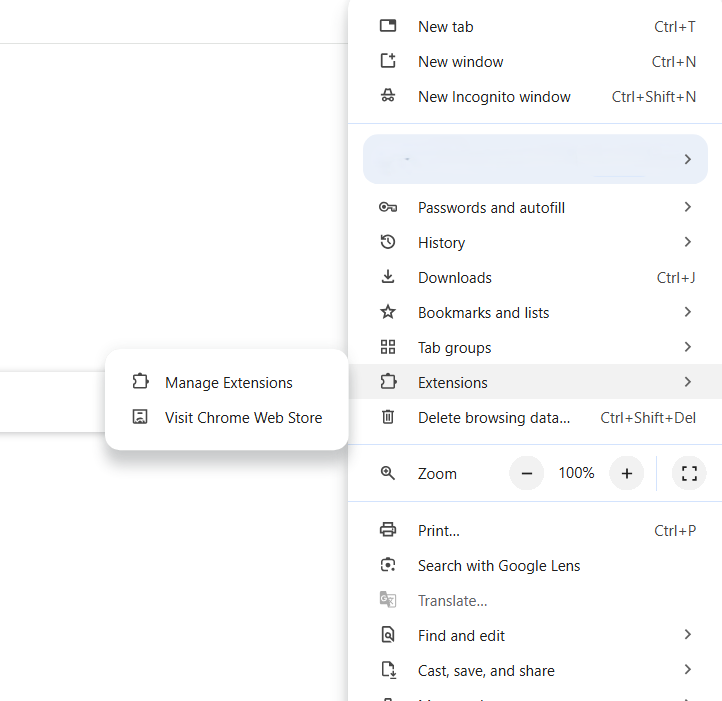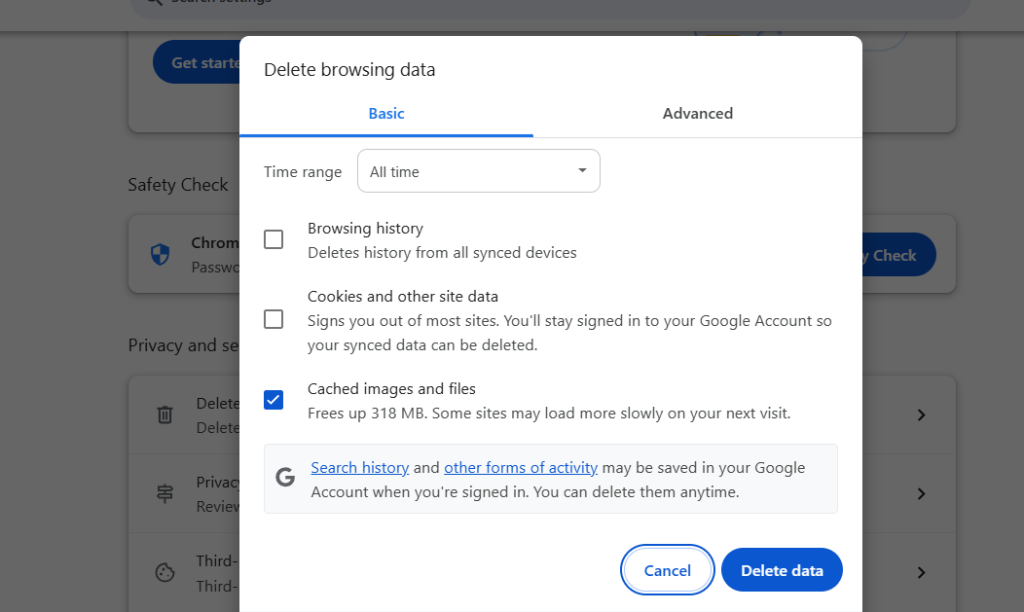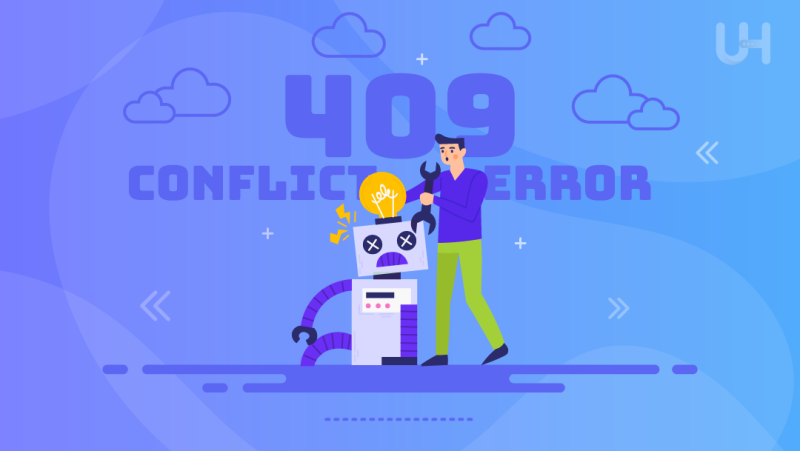Imagine completing a website form, updating your profile, or placing an order, when all of a sudden the page displays an error. The 409 Conflict Error is a little stranger than the well-known “404 Not Found” or the dreaded “500 Internal Server Error.” You must be thinking, what’s that?
When the request you are attempting to make conflicts with what is already taking place on the server, this error message appears. Consider it as if two people were attempting to edit the same document simultaneously; one saves, and the other is suddenly unable to do so. That collision is what we refer to as a conflict.
Developers, site owners, and anyone working with APIs or platforms like WordPress or Magento are more likely to encounter the 409 error. Don’t worry, though; you’re not the only one who has encountered this problem. Let’s discuss the 409 Conflict Error, its causes, and most importantly, step-by-step instructions for fixing it.
Key Takeaways
- Retry the request with updated data to ensure it aligns with the latest version of the resource and avoids version conflicts.
- Clear your browser cache and cookies to eliminate any outdated or corrupted data that may be causing request issues.
- Double-check the requested URL for typos or errors that might be directing the request to the wrong or unavailable resource.
- Disable any browser extensions or plugins that could be interfering with how requests are sent or received by the server.
- If the error began after a recent software or plugin update, consider rolling back the update to see if it resolves the issue.
- Review your server configuration files and error logs to identify any misconfigurations, slow database queries, or timeouts.
- Use concurrency control techniques such as ETags, versioning, or timestamps to handle multiple users editing the same resource.
- If the cause of the 409 error is unclear, reach out to your API provider or hosting administrator for further assistance and guidance.
What is a 409 Conflict Error?

The 409 Conflict Error is an example of an HTTP status code that is described in the HTTP/1.1 standard. This status indicates that the specific request cannot be completed because of a conflict with the current state of the resource.
In simpler terms, it indicates that the server understands the request, but is unable to process it because doing so would create an inconsistency or duplication.
The term conflict in a request such as this would mean that the requested action cannot be completed without some form of collision occurring, such as overwriting, duplicating a record, or some deviation of a resource’s constraints. This is a common issue with REST APIs, where two users or processes try to concurrently update a single resource.
It is also seen in version control systems, in web applications during submissions of multiple or repeat forms, or when Content Management Systems such as Magento, WordPress, or WooCommerce experience content or database conflicts from plugins, rogue processes, or duplicate operations.
Common Causes of 409 Conflict Errors
The 409 Conflict Error is often caused by contention issues where multiple processes try to access and modify the same resource, leading to a denial of the request to avoid complexity and server overload.
One of the most apparent resource version conflicts is in the case of using outdated data to update data on a REST API server. The server will not allow the update to go through, as it will only use the latest data.
Another common source of this problem is user-generated blank submissions of forms caused by repeated pressing of the Submit button. Duplication of form submissions results in redundant data records, which triggers a HTTP 409 error response in the backend.
There are also conflicts caused by a lack of proper data control in multicluster environments, which are caused by multiple nodes or services trying to update shared data concurrently.
Server misconfigurations that deal with the server cache and outdated resources could also create 409 status code errors due to the improper handling of concurrent requests. Furthermore, in environments such as Magento, WordPress, or WooCommerce, plugins or extensions might conflict with each other and interfere with the underlying data processes, producing errors as multiple extensions try to update or process the same data.
Finally, the inconsistent state of the database or records that are locked can hinder the completion of requests, especially during high-volume operations or when there is a mismanagement of transaction control.
How to Diagnose a 409 Conflict Error
Resolving issues with 409 Conflict Errors begins with tracing back to the source of the conflict. To start, check if the browser console and developer tools are showing failed network requests, as this can unveil hidden network requests and let you check headers and payload data.
This approach is especially handy in examining the submission of forms and other AJAX-powered activities. For more thorough analysis, check server logs, and the Apache or NGINX error logs can help determine the timing and location of conflicts in server processes.
While handling APIs, you can test them with Postman or cURL to see how the server responds to your request. These applications also allow you to change headers, HTTP methods, and payloads to check for conflicts, whether versioning conflicts or submission of duplicate data.
In content management systems such as Magento, WordPress, or WooCommerce, debugging a system or checking logs often reveals the existence of plugins that are in conflict with other software or other problems associated with data handling.
For software engineers collaborating on a shared server, you can identify unfinished changes in your source documents, which signal that several edits have been made to a single file concurrently and need to be cleaned up and submitted individually to be merged with the main version.
How to Fix a 409 Conflict Error (Step-by-Step Solutions)

Simultaneous or conflicting actions with a resource in an API context often lead to 409 Conflict Errors. Scrutinizing resource versioning prior to sending update requests is a good starting point. APIs with versioning either have a version field or a timestamp. Making sure your application includes the latest version enables auto-conflict resolution.
ETag implementations are also very beneficial. ETags are identifiers for a specific version of a resource. They allow the server to confirm resource modification with the request of If-Match or If-None-Match headers. This is very useful to avoid unintended overwrites.
Also, be cautious with your HTTP verbs. Non-idempotent verbs, especially PUT, PATCH, or DELETE in conjunction with poor application-layer coordination in multi-user applications, it can be troublesome. Concurrency control should be implemented in API logic to handle concurrent conflicting requests by either rejection or queuing.
Fixing Conflicts in Web Applications
In web applications, 409 errors are commonly caused by duplicate transactions. This occurs when users click the submit button multiple times, or when they refresh the page mid-transaction. One way to solve this problem is to refine interactions by implementing disabling mechanisms; swiftly moving the cursor to show a loading spinner or blocking form submission via JavaScript would prevent multiple clicks.
Also, don’t forget to implement CSRF tokens or unique request IDs for form and API calls. These tokens help to make sure each submission is processed once and aid the server in recognizing and rejecting attempts to submit duplicates.
In addition, the application status on the client and server sides should be aligned. If the client, for example, is sending stale or outdated data, erroneous views, or local caching, there should be mechanisms to update to the current state before data submission.
Magento/WordPress-Specific Fixes
For users of Magento or WordPress, or WooCommerce, a 409 error code is frequently caused by the conflict of plugins or extensions, particularly those involving database transactions, product handling, or custom forms. A good starting approach to resolve this issue is to clear the cache and do a reindex (on Magento) to refresh stale data that is being cached and inconsistent.

Check if any extension has malware or is causing any problem, then remove it.

If the issue still is not resolved, consider finding the module or plugin that is causing the issue by disabling them one by one or enabling debug logs to trace the source. Most of the time, an update, rollback, or reinstallation of the plugin is sufficient to resolve the issue. Also, in eCommerce situations, look for possible inventory synchronization issues.
For instance, constantly adding or removing a product from different locations can cause a problem. Resyncing the inventory or fixing broken database pointers can reestablish equilibrium.
Database-Level Fixes
In systems that manage a large amount of data, 409 errors can arise from underlying databases. One of the most common issues is a record lock. This is where database records are being written to or held by another process.
Using database monitoring tools or logs to track the execution of processes can help in identifying very old processes or locked rows. Fixing or killing those processes can enable the locked data to be accessed.
Inappropriately ID records, which might appear as failed record submissions, imports, or bugs in the application logic, need attention as well. These record inconsistencies can be rectified manually using SQL queries or automatically using validation scripts.
Proper error traps, control windows, and retry methods need to be implemented. This allows your database to handle multiple accesses as well as avoid conflict.
Need More Power to Handle Conflicts Smoothly?
Avoid resource-related errors and ensure seamless performance with a High-RAM VPS. Whether you’re dealing with APIs, running complex applications, or managing heavy traffic, Ultahost’s High-RAM VPS gives you the stability and power you need.
7 Easy Ways to Fix 409 Conflict Error
409 Conflict Errors can be annoying, especially if you don’t know the underlying cause, but they can be simple to fix. Here are ten different ways to troubleshoot the issue and fix the error.
Check for Duplicate Resource Requests
A 409 Conflict Error can be triggered if you are trying to create a resource that already exists. Also, when you are trying to register a user with an email that is already registered in the system. Resolving this issue is as easy as making sure the resource is not already in existence. Make sure your clients are validated and your server provides user-friendly messaging for duplicates and errors.
Use Idempotent HTTP Methods
Idempotent methods are safe to use and can be controlled with GET, PUT, or DELETE. If your operation is carried out using POST, your operation can be carried out with PUT. This is a simple change. However, it can limit accidental duplicates and the chances of a 409 error due to retries.
Implement Proper Version Control
Many attempts to change the resource from different clients or services can lead to inconsistencies. That in turn resulted in a 409 error. To rectify this, incorporate mechanisms like ETags or timestamps, as they provide a way for the server to track alterations. Moreover, they ensure that updates are made only when the correct version is in place. This orderly approach minimizes data conflicts.
Use Optimistic Concurrency Control
With this method, the application operates on the assumption that all data is unaltered and only verifies for conflicts during the finalization stage. If conflicts are detected, for instance, through versioning or timestamps, the change is canceled. This model is effective and particularly useful for RESTful APIs as it reduces unnecessary operational overhead.
Conflict errors can occur due to the storage of stale data from corrupted or outdated cookies and browser caches. Resolving these issues requires clients to remove stale headers or verifiers and refresh. Clearing these caches is beneficial. Users can refresh their sessions or perform the request in incognito mode to determine if the problem is solved.

Review API Documentation and Endpoint Rules
Given the complexity of APIs, the problem might be the way an API endpoint is understood. Go through the API documentation to check whether you’re non-compliant with constraints. You should check for factors like a maximum number of entries, duplicates, or updates that are not allowed.
Check for compliance with mandatory headers, the data to be sent, the expected format, and the behavior of the endpoint. For this purpose, Postman can be used to confirm whether the expected behavior is achieved with the given parameters.
Log and Monitor Server-Side Activity
If the 409 error is still showing, check your server and enable more detailed logging on it. Look through the records and find out the requests that are conflicting and the reason behind them. Some monitoring tools can also be used to find some conflicts that might be causing some issues. With all this data, the backend can handle smarter programming for the difficult situations.
Best Practices to Prevent 409 Conflict Errors
Irrespective of the 409 conflict error, both the user and the developer face inconvenience. Nonetheless, the proper strategies can sometimes eliminate the error.
Implement Version Control and Concurrency Management
Implementing version control in your system can help mitigate the 409 errors. When multiple users or services are implementing changes to the same resource, there is a high chance of conflicts.
Techniques such as ETags, timestamps, and optimistic locking tell the clients to notify the server what version they are trying to update. In the event the server finds the client version and the resource version out of sync, the server has the option to either deny the update or request the client to refresh the data. In either case, data integrity is maintained, and the risk of newer values getting overwritten by older data is mitigated.
Use Idempotent HTTP Methods
Likewise, another best practice is to focus the structure of your API around idempotent methods, particularly during update operations. For example:
- Change Posting resource to updating resource. Use
PUTinstead ofPOST. - Avoid side effects when requests are repeated.
Validate Data Thoroughly on Both Client and Server
Inadequate input validation is a common cause of 409 Conflict Error Responses. It happens when the data sent fails due to contradicting existing records. To fix this:
- Implement form validation, duplicate detection, and pre-submission alerts on the client side.
- On the server side, ensure data integrity, validate unique fields, check foreign key relationships, as well as other business rules.
When a conflict occurs, return errors to the user interface so that clients can make appropriate corrections.
Set Up Automated and Manual Conflict Resolution Mechanisms
For complex workflows, especially in collaborative systems, anticipating the possibility of conflict and designing the processes is a critical consideration:
- Implement retry mechanisms with exponential backoff to reduce the number of simultaneous requests hitting a given server.
- Use auto-merge strategies where applicable, for example, merging non-overlapping edits from two different users to the same document.
- Give users manual control of resolution so that users can dictate which version to retain, similar to merge conflict resolution in Git.
This user-centric methodology provides control as well as resilience to applications while preventing silent failures.
When to Contact Support or a Developer
Dealing with a 409 Conflict Error is a bit trickier than a cache purge or a simple header tweak. If you’ve done the basics and the problem is still there, some deeper action is required.
If You’re Using a Managed Platform
Services like Magento Cloud or Shopify, and even some Managed WordPress Hosting Services, have their backend access heavily limited. This means that you might not be able to access server logs, configuration files, version control, and many more. Here, the support staff from the platform can examine backend logs and configuration files to verify settings.
When You Can’t Trace the Source of the Error
In the case you do not know if the error comes from an API call, a plugin conflict, or a problem with the database, and all attempts to debug have failed, you should turn to a developer.
A developer can view server logs and diagnose the issue using Postman and the developer console of the browser.
Always Provide Clear Logs or Screenshots
Add the following items to help contact support in resolving the issue.
- Error Screenshot
- Also, the relevant API endpoint or the URL that is connected to the problem.
- Error log provided by the browser or server.
- Prior to the server error, console error logs.
- Modification Logs (Plugin Updates, Code Updates, API Updates, etc.)
These will enhance standard troubleshooting and assist the engineering teams in swiftly resolving the matter.
Conclusion
Resolving 409 Conflict Errors is crucial for not disrupting the flow of a website or application. These errors can indicate competing API calls, outdated server interactions, or chaotic data workflows can cause major issues. Rather than waiting for the errors to occur, a more efficient approach would be to implement monitoring systems. Also, consider routinely auditing the code, API interactions, and enforcing stringent control systems for synchronization and versioning.
If you’re tired of debugging and want a smoother experience, consider switching to Ultahost’s WordPress VPS Hosting that’s built for performance and stability. Check out Ultahost’s website and give your site the reliable backend it deserves.
FAQ
What does a 409 Conflict Error mean?
A 409 Conflict Error is a response to a request that cannot be fulfilled due to a conflict with an existing resource, which may be a repeating or an outdated version.
Is a 409 Conflict Error a client-side or server-side issue?
Although usually categorized as a server-side issue, a 409 Conflict Error is often caused by client-side actions like form spamming or using stale information.
What causes a 409 Conflict Error in REST APIs?
Concurrent modification of a resource, trying to update a resource that’s already been modified, the resource must be created or the resource already exists, and many more attempts to perform actions on the already modified resource are common reasons for triggering the error 409 Conflict.
How do I fix a 409 Conflict Error in a web form?
Address issues on both the client and server sides. Ensure that no more than one form submission is enabled to avoid duplicate submissions.
Can a plugin or extension cause a 409 Conflict Error?
Yes, conflicts caused by installing multiple plugins or extensions, specifically within a CMS based system, cause conflicting resources that result in a 409 Conflict Error.
What’s the difference between a 409 Conflict Error and a 422 Unprocessable Entity?
Both are viewed as client-side errors. 409 is the error that happens when the resource a client is interacting with conflicts with the proposed action.
422 pertains to a situation where a request is crafted optimally, yet the entity is lacking the requisite information or oversupplies the information.
How can I prevent 409 Conflict Errors in the future?
In avoiding 409 errors, it is highly recommended the implement unique versioning with optimistic locking or other methods that deal with concurrent update retrieval to avoid duplication.










